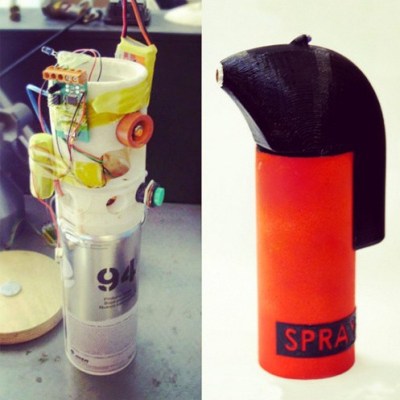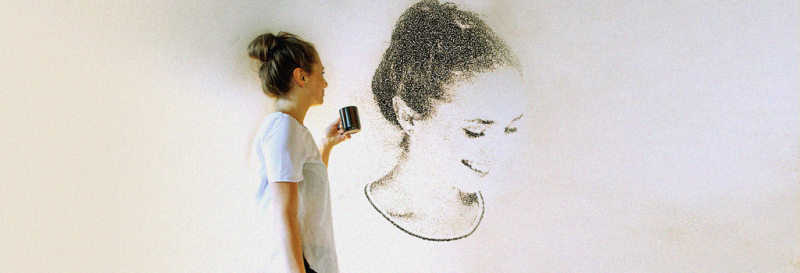SprayPrinter is a neat idea. You download a cellphone app, point the camera at a wall, and sweep the wall with a spray can fitted with a (Bluetooth? WiFi?) remote-controlled valve. The phone knows where the nozzle is, and sprays a dot whenever it needs to “paint” the picture of your choosing on the wall.
 While we’re not sure that we have the patience to paint our walls this way, it’s a cool effect. But even more, we love the idea of using the cellphone camera for location sensing. Many robotics applications do just this with an overhead camera.
While we’re not sure that we have the patience to paint our walls this way, it’s a cool effect. But even more, we love the idea of using the cellphone camera for location sensing. Many robotics applications do just this with an overhead camera.
Of course, we’d love more detail about how it’s done, but it’s not hard to guess that it’s either a bit of machine vision in the phone, or simpler still, that the spray-can housing has IR LEDs inside that the phone can lock onto. Indeed, the prototype version of the product shown here does look like it has an LED on the opposite side from the orange nozzle.
It wouldn’t be hard to take this to the next level, by adding enough IR LEDs that the camera in your phone can sense orientation as well as location. Heck, by measuring the distances between LEDs, you could probably even get a rough measure of depth. This could open up the use of different nozzles.
Thanks [Itay] for the tip! Some images courtesy SprayPrinter, via designboom.















?
Why is he moving the spray can in lines over the wall? And why are the dots evenly spread horizontally, but not vertically? If the location of the device is really known, then you could plot each pixel precisely, both horizontally as wel as vertically. To paint the picture, it would be even better to move the spray can randomly over te wall.
It seems like only the horizontal position of the spray can is actually determined by the device. The vertical lines are seemingly determined by the user moving the can.
I think that makes it a bit useless, although it does make every picture unique. I’m not sure about this. Nice gimmick. But if you make a contraption similar to this: http://spritesmods.com/?art=whiteboard&page=2, it would probably work better and is almost as easy to set up.
I think the main issue is parallax. [Sprite_TM’s] implementation has two observers but this is a single smartphone as observer.
It looks like there are a couple prototype iterations so far, and one of them looks like they were only tracking X. The portrait of the woman looks like they must have been tracking Y as well.
I want to see them break the XY grid, and do something more free-form and interactive. A duet between the painter and the computer. (But that’d be “art” and not “product”.)
Very interesting idea. I’ll have to visit the Tartu Science Park next time my wife and I visit her family in Estonia.
How long to see this on kickstarter ?
I did a quick google search just it see if it was there or on indiegogo and while i didn’t find it, i did find this gem https://www.indiegogo.com/projects/3d-printing-gold-bars
It really does blow my mind how people get some of these things funded.
It is art!
Their homepage http://sprayprinter.com/ says “Soon on IndieGoGo. Join the ride for early bird rewards!”
So probably never on KS :-)
You can get the distance using WiFi shenanigans, but that gives the same value in arcs across the wall so you also need to use the phone’s camera to determine the position along the arc to compute X,Y relative to the plane of the wall.
I do believe that it is doable.
Do not most smartphones have IR cut filters? iPhones don’t see any Ir LEDs from my testing.
This is a neat idea.
My guesses are either simple pixel motion detection on phone always scan from right to left, or he’s holding a tracker in his hand and faking the phone track, or there is no tracking in its current form and he’s pressing a button for newline feed manually.
My phones / cameras see IR very well. I use them to double-check IR LEDs all the time. Point a remote at your phone camera and find out.
Apple added an IR filter on iPhone4, but I think the forward cameras are still without filter. And all Android phones I’ve tried detect IR just fine on both the front- and back-facing cameras.
You have to pay extra for your iPhone to view IR :-)
There’s gotta be a better use for this idea…
Can’t you use an optical mouse to determine the delta X, delta Y location on the wall? It’ll get much better resolution.
Since you are spray painting it, you do need the proximity anyway, just need to rig the optic system to change to focal length if you want it farther out.
If you use one of the mouse key to mark the origin and by keeping track of that over time allow you to know the offset. Just paint the pixel from a stored bitmap.
Mouse is a cool idea. You’d have to get your integrated error under control (dead-reckoning, right?) but it would be a lot simpler. Mouse + camera would be awesome.
It’s done with bitmapping algorithms.. They probably just have a real programmer which is rare these days..
I’d like to add. This is so impressive I predict nothing will come of it, not detail or an expensive product..
Reminds me of hektor
http://juerglehni.com/works/hektor
Could be used with conductive paint to create ad-hoc antennas on any flat surface.